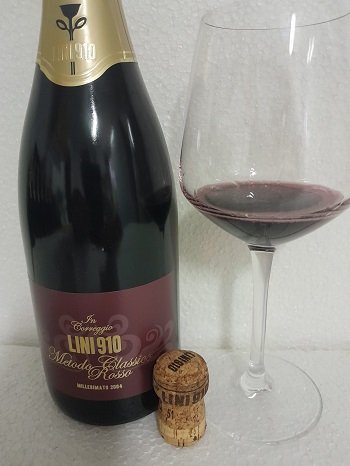Historic vertical tasting of Lambrusco Metodo Classico Rosso In Correggio Lini 910: 10 years minimum aging on yeasts. Seven vintages backward from 2014 just released to 2004.
The most common preconception when it comes to Lambrusco is that of the “unpretentious little wine,” to be drunk cold, very young, undemanding, to be paired, at best, with delicacies from Emilia/Lombardy, especially with pork-based preparations or flavor-rich first courses well awash in butter and Parmigiano. Preconceptions to be completely revised in each of the aspects listed.
First of all, “Lambrusco” , as a designation, is an incorrect generalization: “the” Lambrusco are a diverse ecosystem composed of different types with sometimes diametrically opposed characteristics, both structural and sensory.
One, a hundred, a thousand Lambrusco

The production area historically stretches across the Emilia region, with the provinces of Parma, Reggio Emilia and Modena, with extension to lower Lombardy, in the province of Mantua. Each of these areas is characterized by one or more types of Lambrusco, which characterize peculiarities of the grape variety, territory and technical tradition.
To simplify and do justice to each of these types, although there are more than 60 clones of Lambrusco varieties, here are the most common and famous ones:
- Parma: Lambrusco Maestri, Ancellotta
- Reggio Emilia: Grasparossa, Montericco, Marani, Ancellotta, Maestri
- Modena: Sorbara, Grasparossa di Castelvetro, Salamino di Santa Croce, Marani
- Mantua: Viadanese, Maestri
This is actually complicated in that in each of the types there are, depending on the residual sugar, dry, dry, and amabile versions. With further diversification by technical methodology: classic method, ancestral (also refermented in the bottle but without disgorging), Martinotti or Charmat method (also Charmat Lungo depending on the producer’s philosophy).
Our vertical
 Not wishing to go into every recondite variable, specific characteristics of the grapes and connotations of the resulting wines (which we will explore in more detail with ad hoc monographs), the purpose of this vertical of Lambrusco Metodo Classico that we are going to describe is to break down some of the aforementioned preconceptions: undemanding wine, wine without aging capacity, “simple” wine sensually.
Not wishing to go into every recondite variable, specific characteristics of the grapes and connotations of the resulting wines (which we will explore in more detail with ad hoc monographs), the purpose of this vertical of Lambrusco Metodo Classico that we are going to describe is to break down some of the aforementioned preconceptions: undemanding wine, wine without aging capacity, “simple” wine sensually.
We have chosen a true icon of Lambrusco , the Lambrusco Metodo Classico Millesimato in Correggio by Lini 910 of the variety Lambrusco Salamino, with a minimum aging of 10 years on yeasts.
The company Lini 910
A nod to the Lini 910 winery , dutifully thanking the entire family and, in particular, Alicia Lini who was instrumental in making the tasting a success.
Lini 910 is so called precisely because it was founded in 1910 in Correggio, a small town in the province of Reggio Emilia, almost on the border with the province of Modena. Sparkling wine makers by vocation and reputation, they have studied the technique in France having access, through technical collaboration and commercial interests, to the Maison Mumm in Reims. So much so that they produce some of the best Metodo Classico in the entire region (and, I might add, Italy) using old Pinot Noir vineyards from historic suppliers in Oltrepò Pavese. Transferring this concept to Lambrusco Salamino was the natural evolution: fierce selection of older vineyards, much lower yields than usual standards, maniacal care in the sparkling process and great technical expertise. After 10 years on the lees, here appears a Lambrusco with unique characteristics, unthinkable complexity, maintaining the original characteristics of the grape variety, indeed, exploring meanders then unknown for the type.
Tidbit among the goodies, a small quantity of old vintages put back on the market almost two decades after the vintage, along the lines of the Collections of the cuvées de Prestige of the great Champagne Maisons.
N.B.: the ratings, in the descriptive notes of the Lambrusco vintages that follow, are relative to the type, as always for us at DoctorWine.





